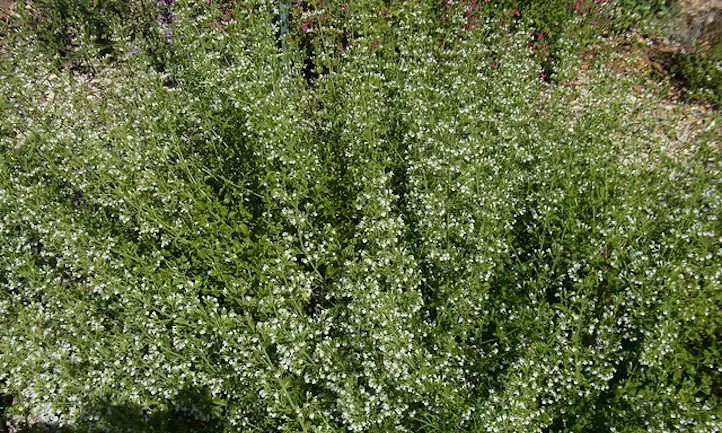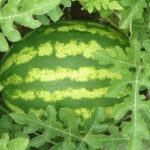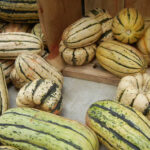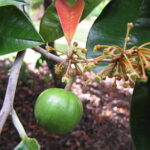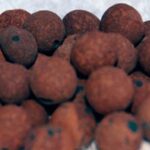Attention distracted gardeners… we have a plant for you! It’s extremely drought resistant, grows in practically any soil, and tolerates shade. Pests and diseases stay away from it, even though it’s edible to humans. You’re going to love all these benefits of the calamint plant.
Calamints are low-lying, bushy plants with cone-shaped clusters of fragrant flowers. Their bloom time stretches from early summer to late fall, attracting all sorts of pollinators. The small, tubular blossoms are distributed through the plants such that they look like clouds of flowers. You can find species in white, lilac, red, pink, and even blue.
Calamint leaf is harvested for use in tea, medicine, recipes, and is a component of the Mediterranean seasoning za’atar. When bruised or crushed, the foliage releases a minty fragrance that’s perfect for cooking. The tea brewed from calamint is aromatic, sweet-tasting, and refreshing.
Unsurprisingly, Calamint is a member of the mint family. It originated from the Mediterranean, including southern Europe and some Middle Eastern and Asian countries. In the garden, calamint works well as a groundcover or filler in landscaping. It only reaches about a foot tall but spreads out as it ages. Gardeners love that these plants are extremely low-maintenance and frost hardy in zones 4-7.
Now that we’re familiar with these incredible plants, we’ll dive into the details. You’ll be surprised by how simple it really is to help calamint thrive.
Quick Care Guide
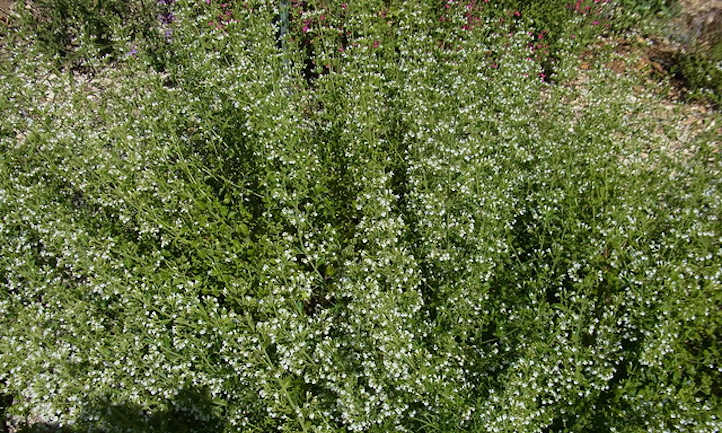
| Common Name(s) | Calamint, calamintha, field balm, basil thyme, spring savory, lesser calamint, mint savory, showy calamint, large-flowered calamint, woodland calamint, wood calamint |
| Scientific Name | Calamintha nepeta, C. grandiflora, Calamintha sylvatica, Acinos arvensis |
| Days to Harvest | 5 months |
| Light | Full sun |
| Water: | Light watering; drought tolerant |
| Soil | Any; Well-draining |
| Fertilizer | None |
| Pests | Whiteflies |
| Diseases | Powdery mildew |
Calamint Varieties
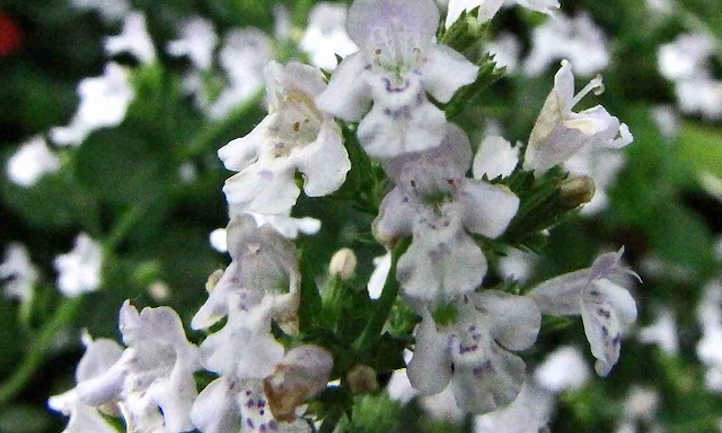
There are around eight varieties of closely related calamintha, four of which we’ll go over. All are part of the mint family but have different needs than true mint.
Calamintha nepeta (Lesser calamint, field balm, Calamintha nepeta ssp. Nepeta, Calamintha officinalis, white cloud)
This is the variety you’ll probably hear about the most, sometimes by the name C. Officinalis or white cloud. Lesser calamint reaches one to one and a half feet tall and spreads out like a mat. It has grayish-green leaves and white flowers that also come in shades of lilac, and light blue. Lesser calamint is said to smell like pennyroyal and taste a bit like spearmint.
Calamintha grandiflora (Mint savory, showy calamint, large-flowered calamint)
The name ‘Grandiflora’ hints toward the identifier of this one. It has the biggest flowers of all the species, although they’re still pretty small. These relatively large blooms are a bright pink that stand out against vibrant green foliage. This species also has a variegated version that sports dappled white and green foliage with bright purple blooms. Unlike other species, C. grandiflora grows best with a little shade rather than full sun.
Mint Savory has a whole cocktail of aromas. It’s been reported to smell like thyme, catnip, mint, pennyroyal, and pineapple. Tea made from its foliage is said to be extremely refreshing.
Calamintha sylvatica (Woodland calamint, wood calamint)
C. sylvatica has a milder taste than calamint calamintha nepeta but is still an excellent flavoring in recipes. It makes a sweet-tasting tea that has hints of mint and marjoram. C. sylvatica features dainty, light purple flowers and a structure that can handle warmer climates than the other species (up to zone 10). It comes from Western Europe and typically grows in the dry banks of Great Britain.
Acinos arvensis (formerly Calamintha acinos, basil thyme)
This variety smells faintly of thyme but isn’t used as a substitute for it. Instead, it has a peppery taste that’s great in recipes. Basil thyme has a fuzzy stem and foliage, accompanied by light purple or pink flowers. It can grow in zones 4-8, but does best in zone 4. Unlike the other shade-tolerant species, basil thyme requires full sun.
Planting Calamint
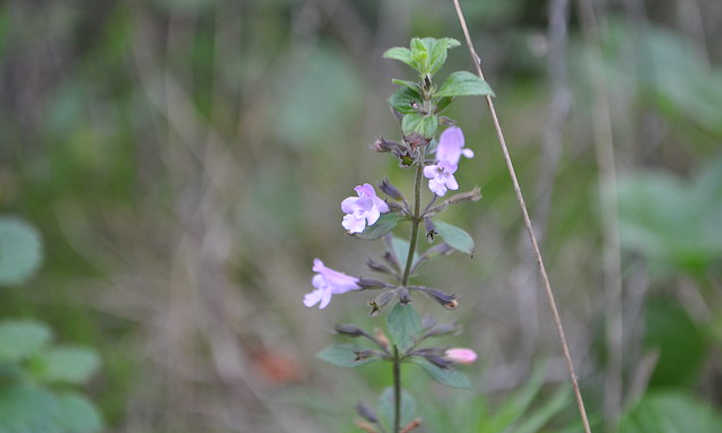
In the United States, not many retailers sell seedlings of this plant, so you’ll likely have to rely on seeds or cuttings. Luckily, both are easy to grow, so you’ll have your sweet-smelling flowers in no time!
Seeds should be started indoors or in a greenhouse in early spring (keep the temperature around 70°F). Sow the seeds ¼ inch deep or less in well-draining soil and keep them moist. Under these conditions, it takes about two weeks for them to germinate, with leafy growth coming soon after.
The cuttings are likewise best started in the spring. Take a good-sized stem cuttinge and stick it directly in well-draining soil. Keep the soil moist and it should be established in about a month.
Whether you started with seeds or cuttings, transplant the baby plants into their permanent spaces in early summer or when they have a strong root system and are actively growing. Calamint is a rhizome, which means the main root likes to spread out. It will do best with lots of space in the ground, but can also be contained in a raised bed or large container. If you choose an enclosed option though, you may need to keep up with root pruning or division to keep the size down.
The mature plants are drought tolerant, but you shouldn’t take that chance with a seedling. Keep the soil consistently moist until the seedling has matured. If you’re lucky, you may see some blooms within a few months!
Care

Calamint pretty much takes care of itself, so your job is pretty easy! Here are some good guidelines for getting your plants started right.
Light and Temperature
Full sun is ideal for this plant. However, it won’t perform as well in temperatures above 86°F. If you live in an area with consistent temperatures that hot, place your plants in a spot that gets refreshing afternoon shade. C. sylvatica can handle warmer weather better than the other species, but should still be given some shade in heatwaves.
On the flip side, calamint is fairly cold hardy. It can usually handle temperatures as low as 5°F. As a perennial, it typically makes it through the winter just fine, depending on where you live of course.
Water and Humidity
As we mentioned, calamint is a drought-tolerant plant. Ideally, the soil should be kept moist, especially during the summer. Water it lightly when the top inch is dry. Try not to rely too much on the drought tolerance, as this can stress out any vegetation over time.
Soil
Infertile, rocky, loamy, sandy – this plant can handle practically any soil. The only soil quality you really need is good draining. You’ll find that calamint is excellent in rock beds and xeriscaping.
As for pH, it isn’t picky. It grows well in soil that’s slightly acidic, neutral, or a bit alkaline. To really help it thrive, use a soil that’s high in limestone.
Fertilizing
You’re off the hook here because calamint rarely needs fertilizer! The only time you’ll need to apply it is if the soil is seriously nutrient-derived. If that’s the case, use a balanced fertilizer in early spring to build up the soil. This may need to be applied yearly, but most likely you’ll be fine after a single application.
Pruning
Calamint spreads so well that it’s sometimes considered a weed. With proper pruning, you can easily keep it in check so it grows beautifully. At the end of the growing season, clip back up to half of the plant to make room for new growth in the spring. Throughout the summer, you can also give it occasional trims to keep things tidy.
Because it self-seeds so easily, most gardeners deadhead the flowers before they release seeds. The flowers start seeding in September, so do so around then. Remember to clean up after yourself though so seeds aren’t left all over the ground.
You can encourage a second round of blooms by clipping the earliest flowers when they’re just starting to fade. If your calamint is growing vigorously but isn’t flowering well, clip back some of the green to redirect some energy into flowers.
Propagation
Calamint is a rhizome, which means it grows from an underground, horizontal stem that’s packed with proteins and starch. This “root” spreads out beneath the soil and sends leafy, flowering shoots aboveground. Ginger is a classic rhizome, as are canna lilies, bamboo, and lingonberries.
Rhizomes are easily cloned through division and shoots. Division can be done in early spring or fall and requires digging up at least part of the plant. You’ll see that the rhizome is made of shoot-growing nodes connected by fleshy root.
Break off about a quarter of the rhizome in between nodes and untangle the stems. Each portion must have healthy roots in order to survive on its own. Immediately plant the new portion in its new home, at the same depth as the parent plant. Care for the new plant as you do the parent and it’ll be settled down in no time.
Cuttings should be taken in early spring so they’re ready to transplant in the summer. With a sharp knife, cut off a 6” stem just below a node. Stick it in moist, well-draining soil, and keep it in light shade.
Harvesting and Storing
You’ve been enjoying the lovely flavors and minty aroma, but now it’s time to put those flavorful leaves to the (taste) test. The process is simple and the result is delectable!
Harvesting
The leaves can be harvested anytime from late spring to fall. Most gardeners choose to do so when the plant first blossoms, which is when it has the best flavor. Select young, healthy-looking foliage and clip them off at the petiole. It’s recommended to harvest herbs in the morning for optimal flavor. This is a fast-growing plant, so you can harvest up to half of its growth.
Storing
You’ll get the best flavor with any herb if you use it when fresh. Unfortunately, their flavor deteriorates rapidly, so you’ll need to store your leaves properly if they aren’t going to be eaten the same day they were picked. The longer you store these leaves, the less flavorful they’ll be, so try to time your harvest and cooking well.
To preserve the flavor for a week or less, wrap the leaves in a damp paper towel and place it in the crisper drawer in your fridge. Hold off on washing the leaves until you’re just about to use them, as washing removes some of the oils.
For long term storage, there are several ways to dry the leaves that will preserve them for a year. To air dry them, place the leaves on a raised, ventilated surface, like a cooling rack. Leave them in a warm, dry space that’s out of direct sunlight, turning as needed. They should be dry in a week or less.
Oven drying is possible, but must be closely controlled. Set the oven to 90-110°F and leave the door cracked open. If the leaves get too hot, they can lose all their flavor. Monitor the progress and turn the herbs if needed. This whole process usually takes about 3-4 hours.
You can also dry them in a food dehydrator, but you’ll have to turn to the user’s manual for instructions on that. Herbs can also be frozen in a sealed container, though they may lose their shape and taste. If you choose this method, use them within six months of harvesting.
Once your harvest is dry, store it in a sealed container in a cool, dark, and dry pantry. You can use the herbs in tea, as flavorings, or part of a recipe. Their flavor goes well with garlic-based dishes.
Calamint has many medicinal properties, but may also have adverse health effects, especially in pregnant women. Consult with your doctor before using this plant medicinally.
Troubleshooting
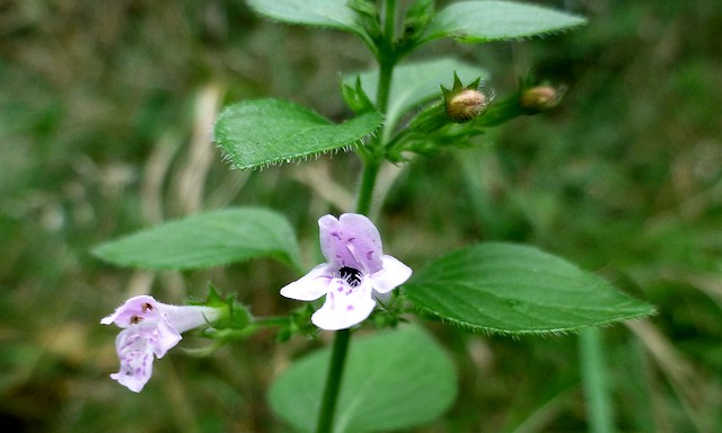
It’s awesome that this plant is low-maintenance but even better than that, it’s pest-resistant! There are only a few minor threats to look out for.
Growing Problems
The most common complaint about this plant is that it reseeds like crazy. Unless you want a garden full of these minty beauties, you’ll need to prune the flowers before they seed or take measures to prevent rooting such as using landscape fabric. If this is a serious issue for you, there are some hybrids of calamint that are sterile, such as C. nepeta ‘Montrose White’.
In hot and humid climates, the leaves may lose their vigor, especially in the summer. Prevent this by planting your calamint in a spot afternoon shade. You should also avoid overwatering, as this will only make things more humid.
Pests
The only pest that’s been consistently reported to bother calamint is the whitefly. This tiny insect has flat, white wings and lays its eggs on the undersides of leaves. It also secretes honeydew, which has a white, cottony appearance. Whiteflies can be very dangerous because they’re carriers for diseases that could prove fatal to your plants.
The simplest method of eradication is to spray the plants with water, which usually washes the insects away. For heavier infestations, try using insecticidal soap or horticultural oil to smother the pests. To prevent whiteflies from settling on your plants, periodically apply neem oil and watch closely for any signs of infestation.
Since we’re talking about insects, we might as well point out the beneficial pollinators that this plant attracts. Calamint is a magnet for bees and butterflies, which will help out the surrounding plants as well. You may even see some hummingbirds joining in on the fun!
Diseases
Powdery mildew is a fungal growth that creates white, powdery-looking spots. It feeds on the leaves and their sap and turns the leaves yellow, then brown. In time, it can stunt your plant’s growth and prevent it from flowering. This dusty-looking fungus will quickly spread throughout the whole plant, so it’s best to catch it early on.
In calamint, this disease usually shows up near the end of the growing season. Be on the lookout for it and immediately prune any leaves showing symptoms. You can also prevent it from taking over by applying neem oil or heavily diluted vinegar (on occasion). Treat an existing infection with potassium bicarbonate, sulfur spray, or copper fungicide.
Frequently Asked Questions
Q: Is calamintha edible?
A: Yes, the leaves are used medicinally and to flavor tea and various dishes. If taken in excess though, it can cause miscarriage in pregnant women.
Q: Is calamintha invasive?
A: In some areas, yes. Calamint spreads very easily and can quickly overtake a landscape. However, consistent pruning will keep it under control.
Q: Where does Calamintha come from?
A: These plants largely come from Asia and the Mediterranean area, which includes Southern Europe and some Middle Eastern countries.

